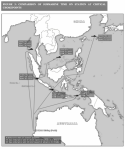I completely disagree. The SSKN is an SSN and is fundamentally different from an SSK. I will post your comparison table with my changes in bold.No, you are incorrect, again.
Stop talking about the SSKN as if it can perform any part of a SSN's role "better," in fact stop comparing it to a SSN to begin with.
This entire framing of the SSKN is almost a waste of time because everyone is automatically comparing the "SSKN" upwards to SSNs with big hopes and dreams of somehow being able to use them to "master stroke" out a fleet of submarines that are "basically like SSNs" with only minor detriments yet at much lower cost and able to be fielded in larger numbers.
I am telling you, that is categorically the wrong way of framing the discussion -- it is not helpful to view the SSKN as if it is some sort of replacement or augmentation to a proper SSN capability, rather what it serves as (if it emerges at all) is to fit the SSK mission profile better.
If we were to roughly breakdown the various "traits" of usual nuclear attack submarines, and usual SSKs, and the proposed "SSKN," relative to one another, we would see this:
Nuclear attack submarine Diesel electric submarine "Mini-nuke" submarine Cost High Low Unknown Submerged endurance High Low High Perishable endurance
(food, crew)High Low Low Speed High Slow Slow to moderate Weapons load High Low Low Size Large Small/medium Unknown, likely small/medium Sensors and processing High Variable Variable Stealth High High High
Keeping in mind that we don't know the SSKN's true characteristics yet, and the few we do "know" are based off rumours right now, we still have enough basis to say that the SSKN is far closer to a SSK in characteristics rather than a genuine SSN -- the only domain in which it is similar to a SSN is its submerged endurance by virtue of being technically nuclear powered.
However in every other domain, including the perishable endurance of the ship (limited by food, crewing facilities), weapons load, hull diameter, sensors and processing capacity, and especially speed, the SSKN is far closer to that of a SSK.
Speed is vital and cannot be underestimated between that of a genuine SSN, because the ability to propel yourself at 30+ knots to ingress or egress out of a situation, with the powerplant to support it cannot be underestimated and it is arguably the most significant difference between that of a SSN and a regular SSK after submerged endurance.
Top speed, and ability to maintain top speed, is not something that can simply be handwaved away --- it is such a massive component of a nuclear submarine's capability profile, that by not having it, is the equivalent of comparing an aircraft limited to subsonic speeds versus an aircraft which is capable of sustained high mach supercruise.
That is why I keep banging on about how this "SSKN" shouldn't be compared with a SSN at all.
| Nuclear attack submarine | Diesel electric submarine | "Mini-nuke" submarine | |
| Cost | High | Low | Unknown |
| Submerged endurance | High | Low | High |
| Perishable endurance (food, crew) | High | Low | High |
| Typical operational speed/ Top speed | Medium(on natural circulation)/ Very high | Very slow(on AIP)/ High | Medium/ High |
| Weapons load | High | Low | Low |
| Size | Large | Small/medium | Unknown, likely small/medium |
| Sensors and processing | High | Variable | Variable |
| Stealth | High | High | High |
Top speed for SSN is primarily used to travel to and from the mission area. They come at significant penalties in terms of sound signatures and sensor performance, and very useful sensors like the towed array can’t be deployed.
The SSKN’s supposed 14kn sustained speed is comparable to a modern SSN running with the reactor on natural circulation. It is far faster than the ~5kn typical of SSKs on AIP.
Endurance-wise there is nothing preventing the SSKN from equalling an SSN. Food takes up very little volume. Amenities like hot showers should also be available unlike on SSKs.
Comparison with fighter jet is not appropriate because the lethality of air launched missiles are highly dependent on launch parameters, but torpedos are not dependent at all.
Like I said previously, the proper way to think about the SSKN is that improvements in small reactor design, high power Stirling engine, and batteries makes small SSN that are previously difficult to make quiet viable again.

